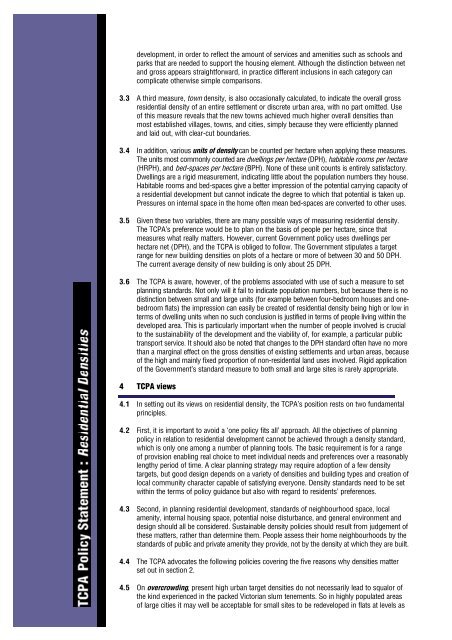Download the TCPA policy statement on Residential Densities
Download the TCPA policy statement on Residential Densities
Download the TCPA policy statement on Residential Densities
Create successful ePaper yourself
Turn your PDF publications into a flip-book with our unique Google optimized e-Paper software.
development, in order to reflect <str<strong>on</strong>g>the</str<strong>on</strong>g> amount of services and amenities such as schools andparks that are needed to support <str<strong>on</strong>g>the</str<strong>on</strong>g> housing element. Although <str<strong>on</strong>g>the</str<strong>on</strong>g> distincti<strong>on</strong> between netand gross appears straightforward, in practice different inclusi<strong>on</strong>s in each category cancomplicate o<str<strong>on</strong>g>the</str<strong>on</strong>g>rwise simple comparis<strong>on</strong>s.3.3 A third measure, town density, is also occasi<strong>on</strong>ally calculated, to indicate <str<strong>on</strong>g>the</str<strong>on</strong>g> overall grossresidential density of an entire settlement or discrete urban area, with no part omitted. Useof this measure reveals that <str<strong>on</strong>g>the</str<strong>on</strong>g> new towns achieved much higher overall densities thanmost established villages, towns, and cities, simply because <str<strong>on</strong>g>the</str<strong>on</strong>g>y were efficiently plannedand laid out, with clear-cut boundaries.3.4 In additi<strong>on</strong>, various units of density can be counted per hectare when applying <str<strong>on</strong>g>the</str<strong>on</strong>g>se measures.The units most comm<strong>on</strong>ly counted are dwellings per hectare (DPH), habitable rooms per hectare(HRPH), and bed-spaces per hectare (BPH). N<strong>on</strong>e of <str<strong>on</strong>g>the</str<strong>on</strong>g>se unit counts is entirely satisfactory.Dwellings are a rigid measurement, indicating little about <str<strong>on</strong>g>the</str<strong>on</strong>g> populati<strong>on</strong> numbers <str<strong>on</strong>g>the</str<strong>on</strong>g>y house.Habitable rooms and bed-spaces give a better impressi<strong>on</strong> of <str<strong>on</strong>g>the</str<strong>on</strong>g> potential carrying capacity ofa residential development but cannot indicate <str<strong>on</strong>g>the</str<strong>on</strong>g> degree to which that potential is taken up.Pressures <strong>on</strong> internal space in <str<strong>on</strong>g>the</str<strong>on</strong>g> home often mean bed-spaces are c<strong>on</strong>verted to o<str<strong>on</strong>g>the</str<strong>on</strong>g>r uses.3.5 Given <str<strong>on</strong>g>the</str<strong>on</strong>g>se two variables, <str<strong>on</strong>g>the</str<strong>on</strong>g>re are many possible ways of measuring residential density.The <str<strong>on</strong>g>TCPA</str<strong>on</strong>g>’s preference would be to plan <strong>on</strong> <str<strong>on</strong>g>the</str<strong>on</strong>g> basis of people per hectare, since thatmeasures what really matters. However, current Government <str<strong>on</strong>g>policy</str<strong>on</strong>g> uses dwellings perhectare net (DPH), and <str<strong>on</strong>g>the</str<strong>on</strong>g> <str<strong>on</strong>g>TCPA</str<strong>on</strong>g> is obliged to follow. The Government stipulates a targetrange for new building densities <strong>on</strong> plots of a hectare or more of between 30 and 50 DPH.The current average density of new building is <strong>on</strong>ly about 25 DPH.3.6 The <str<strong>on</strong>g>TCPA</str<strong>on</strong>g> is aware, however, of <str<strong>on</strong>g>the</str<strong>on</strong>g> problems associated with use of such a measure to setplanning standards. Not <strong>on</strong>ly will it fail to indicate populati<strong>on</strong> numbers, but because <str<strong>on</strong>g>the</str<strong>on</strong>g>re is nodistincti<strong>on</strong> between small and large units (for example between four-bedroom houses and <strong>on</strong>ebedroomflats) <str<strong>on</strong>g>the</str<strong>on</strong>g> impressi<strong>on</strong> can easily be created of residential density being high or low interms of dwelling units when no such c<strong>on</strong>clusi<strong>on</strong> is justified in terms of people living within <str<strong>on</strong>g>the</str<strong>on</strong>g>developed area. This is particularly important when <str<strong>on</strong>g>the</str<strong>on</strong>g> number of people involved is crucialto <str<strong>on</strong>g>the</str<strong>on</strong>g> sustainability of <str<strong>on</strong>g>the</str<strong>on</strong>g> development and <str<strong>on</strong>g>the</str<strong>on</strong>g> viability of, for example, a particular publictransport service. It should also be noted that changes to <str<strong>on</strong>g>the</str<strong>on</strong>g> DPH standard often have no morethan a marginal effect <strong>on</strong> <str<strong>on</strong>g>the</str<strong>on</strong>g> gross densities of existing settlements and urban areas, becauseof <str<strong>on</strong>g>the</str<strong>on</strong>g> high and mainly fixed proporti<strong>on</strong> of n<strong>on</strong>-residential land uses involved. Rigid applicati<strong>on</strong>of <str<strong>on</strong>g>the</str<strong>on</strong>g> Government’s standard measure to both small and large sites is rarely appropriate.4 <str<strong>on</strong>g>TCPA</str<strong>on</strong>g> views4.1 In setting out its views <strong>on</strong> residential density, <str<strong>on</strong>g>the</str<strong>on</strong>g> <str<strong>on</strong>g>TCPA</str<strong>on</strong>g>’s positi<strong>on</strong> rests <strong>on</strong> two fundamentalprinciples.4.2 First, it is important to avoid a ‘<strong>on</strong>e <str<strong>on</strong>g>policy</str<strong>on</strong>g> fits all’ approach. All <str<strong>on</strong>g>the</str<strong>on</strong>g> objectives of planning<str<strong>on</strong>g>policy</str<strong>on</strong>g> in relati<strong>on</strong> to residential development cannot be achieved through a density standard,which is <strong>on</strong>ly <strong>on</strong>e am<strong>on</strong>g a number of planning tools. The basic requirement is for a rangeof provisi<strong>on</strong> enabling real choice to meet individual needs and preferences over a reas<strong>on</strong>ablylengthy period of time. A clear planning strategy may require adopti<strong>on</strong> of a few densitytargets, but good design depends <strong>on</strong> a variety of densities and building types and creati<strong>on</strong> oflocal community character capable of satisfying every<strong>on</strong>e. Density standards need to be setwithin <str<strong>on</strong>g>the</str<strong>on</strong>g> terms of <str<strong>on</strong>g>policy</str<strong>on</strong>g> guidance but also with regard to residents’ preferences.4.3 Sec<strong>on</strong>d, in planning residential development, standards of neighbourhood space, localamenity, internal housing space, potential noise disturbance, and general envir<strong>on</strong>ment anddesign should all be c<strong>on</strong>sidered. Sustainable density policies should result from judgement of<str<strong>on</strong>g>the</str<strong>on</strong>g>se matters, ra<str<strong>on</strong>g>the</str<strong>on</strong>g>r than determine <str<strong>on</strong>g>the</str<strong>on</strong>g>m. People assess <str<strong>on</strong>g>the</str<strong>on</strong>g>ir home neighbourhoods by <str<strong>on</strong>g>the</str<strong>on</strong>g>standards of public and private amenity <str<strong>on</strong>g>the</str<strong>on</strong>g>y provide, not by <str<strong>on</strong>g>the</str<strong>on</strong>g> density at which <str<strong>on</strong>g>the</str<strong>on</strong>g>y are built.4.4 The <str<strong>on</strong>g>TCPA</str<strong>on</strong>g> advocates <str<strong>on</strong>g>the</str<strong>on</strong>g> following policies covering <str<strong>on</strong>g>the</str<strong>on</strong>g> five reas<strong>on</strong>s why densities matterset out in secti<strong>on</strong> 2.4.5 On overcrowding, present high urban target densities do not necessarily lead to squalor of<str<strong>on</strong>g>the</str<strong>on</strong>g> kind experienced in <str<strong>on</strong>g>the</str<strong>on</strong>g> packed Victorian slum tenements. So in highly populated areasof large cities it may well be acceptable for small sites to be redeveloped in flats at levels as
















